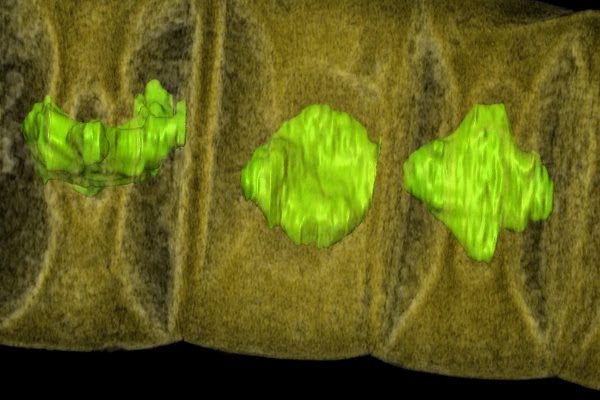Found: Fairy Circles in Australia
The mysterious phenomenon shows up on a new continent.

An Australian fairy circle up close (Photo: Stephan Getzin)
For many years, scientists have puzzled over a striking phenomenon in Namibia—in a regular, hexagonal pattern, plants clear the ground and leave empty circles of earth. These blank spots are called “fairy circles,” because they seem to have been put there almost by magic and because scientists can’t agree on what, exactly, causes them.
Stephan Getzin, an ecological modeler at Germany’s Helmholtz Centre for Environmental Research, once believed that the fairy circles might be created by termites, one of the more popular theories for how the circles are formed. But as he researched them, he changed his mind: it seemed more likely, he wrote in a 2014 paper, that plants self-organize into these mysterious patterns.
That paper promoted an Australian scientist, Bronwyn Bell, to get in touch: fairy circles had been documented only in Africa, but, she wrote to Getzin, Australia had a similar phenomenon. Now, Getzin, Bell, and their colleagues have released a new paper, in the Proceedings of the National Academy of Sciences, that details the discovery of these Australian fairy circles and argues that, here too, the plants organize themselves into this arrangement.

Australian fairy circles from above (Photo: Kevin Sanders)
The Australian fairy circles are found in western Australia, about 10 miles from the town of Newman. As in Namibia, the earth here is dry and water scarce; it’s water competition, argue the scientists who believe the plants self-organize, that drives vegetation here to leave patches of earth bare.
There is a notable distinction between the circles on the different continents. In the Namibian fairy circles, the exposed earth is loamy, and the open circles act as reservoirs of water. Here, the clay surface of the land is hard and dry, and it directs water towards the places where plants are actually growing.
Getzin and his colleagues did look for termite activity in the area where the Australian fairy circles were found, but they found no correlation between termite activity and the pattern of plants. One scientist who believes the Namibian circles are the work of termites, Norbert Jürgens, told the New York Times that he might not actually call the Australia circles “fairy circles” because their clay characters makes them function differently.
The discovery of the Australian fairy circles hints that maybe there are more of these out there in the world: they’re hard to identify from the ground, since they’re spaced far enough apart that it’s often impossible to see the next circle over while standing in one. Much easier is to find them in aerial photos, and in this age of satellite photography, there are plenty of those. Maybe all we need to do is look, and we’ll find more fairy circles—and, finally, a definitive answer to what causes them.
Bonus finds: Prime numbers aren’t so random after all
Every day, we highlight one newly found object, curiosity or wonder. Discover something amazing? Tell us about it! Send your finds to sarah.laskow@atlasobscura.com.






















Follow us on Twitter to get the latest on the world's hidden wonders.
Like us on Facebook to get the latest on the world's hidden wonders.
Follow us on Twitter Like us on Facebook